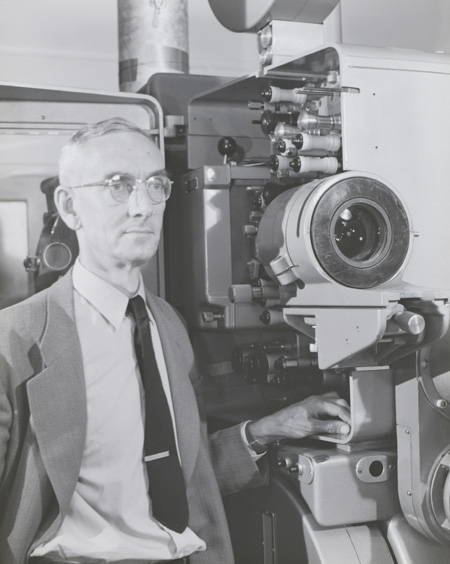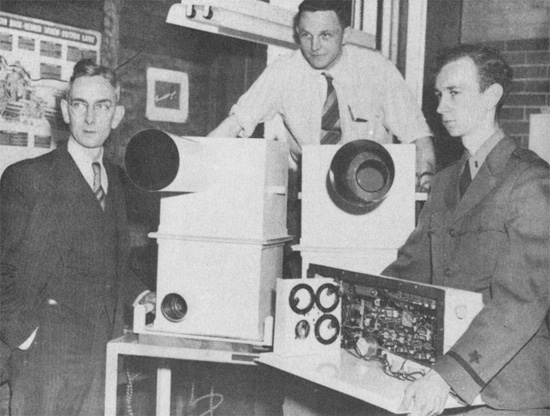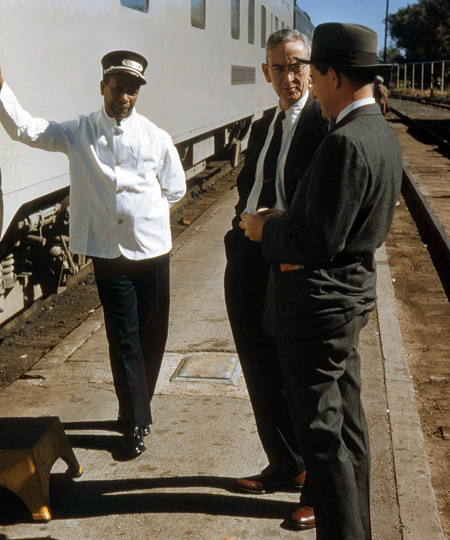Brian O'Brien Biography |
Read more at in70mm.com The 70mm Newsletter |
| Written by: Walter P. Siegmund and Brian O'Brien, Jr. Text prepared for in70mm.com by Anders M. Olsson, Sweden | Date: 26.07.2016 |
Early Years |
|
 Dr.
Brian O'Brien when he was Director of
the Research and Development at American Optical. He is seen here next to
the prototype Philips DP70 7Omm projector installed at AO. Dr.
Brian O'Brien when he was Director of
the Research and Development at American Optical. He is seen here next to
the prototype Philips DP70 7Omm projector installed at AO.Brian O'Brien was born in Denver, Colorado, in 1898 to Michael Phillip and Lina Prime O'Brien. His education started in the Chicago Latin School from 1909–1915, and continued at the Yale Sheffield scientific school where he earned a Ph.B. in 1918 and a Ph.D. in 1922. He also did additional course work at MIT and Harvard. In 1922 he married Ethel Cornelia Dickerman and they had one son, Brian, Jr. After Ethel Cornelia died, he was married a second time to Mary Nelson Firth in 1956. He was a research engineer with the Westinghouse Electric Co. from 1922 to 1923. During this period he developed, along with Joseph Slepian, the auto-valve lightning arrestor, which is still in use today. In 1923 he moved to the J. N. Adam Memorial hospital in Perrysburg, N.Y., a tuberculosis sanitarium run by Buffalo's Public Health Dept. Prior to the advent of antibiotics the primary treatment for tuberculosis was fresh air and sunshine. There was some evidence that sun tanning did help in the remission of the disease. However, Perrysburg—40 miles south of Buffalo—had very little sunshine in the winter. Therefore O'Brien, as physicist on the staff, developed carbon arcs with cored carbons that very closely matched the solar spectrum. With this development the patients could have sun therapy year-round. Due to a general interest in the biological effects of solar radiation, he published some of the early work on the ozone layer and erythema caused by the sun. O'Brien moved to the University of Rochester in 1930 to hold the chair of physiological optics. Shortly thereafter he became the director of the Institute of Optics. His continuing interest in the biological effects of solar radiation led to research in vitamin chemistry. The need for vitamin D, especially in the diet of children, had been recognized for preventing the disease rickets, resulting in the loss of bone calcium and hence deformation of the long bones. At that time there was no synthetic vitamin D, but the dehydrocholesterol in milk can be converted to vitamin D by radiation with ultraviolet light. The carbon arcs developed at Perrysburg were an ideal source of ultraviolet, but for proper irradiation, the milk had to be in a very thin film. Flowing down a solid cylinder produced a suitable film, but the flow volume was much too low to be practical. Free flow from an annular slit might work, but surface tension would collapse the film shortly after leaving the slit. However, if by suitable vanes the milk was given an angular velocity prior to leaving the slit, centrifugal force would counteract the surface tension and a thin free-flowing film would be produced. Thus, a film of high enough flow volume for commercial application was produced, and vitamin D-fortified milk became widespread. Since photographic materials had been a major tool in much of his work, he became interested in the properties of silver halide emulsions. In order to study the reciprocity effect at very short exposure times, he developed a very high-speed slit camera that later was developed into a framing camera with frame rates up to eleven million frames per second. This was later used to great effect in the nuclear energy program, including the Bikini bomb tests. |
More in 70mm reading: Walter Siegmund Interview Todd-AO How It All Began The Ethel O’Brien Printer. Letters from Walt You are in the Show with Todd-AO Brian O'Brien, Jr. Passed Away Walter Siegmund Remembered Todd-AO Birth date Internet link: Project Crossroads. |
Wartime |
|
 Brian O'Brien, Gordon Milne, and Brian O'Brien, Jr. pack up camera for
project Crossroads. Brian O'Brien, Gordon Milne, and Brian O'Brien, Jr. pack up camera for
project Crossroads.By observing events in Europe it became obvious to him that the United States would sooner or later become involved in a major war, and so he began to prepare The Institute of Optics for contribution to the war effort. Among the preparations: Major expansion of instrument shop facilities, stocking up on potentially scarce materials such as high-strength aluminum, and expanding development staff. Early on, the Office of Scientific Research and Development was formed, headed by Vanever Bush, reporting directly to the White House. Under the OSRD there was formed the National Defense Research Committee with various subdivisions. Section D, handling instrumentation, was formed under George Harrison, and Section D6 was headed by O'Brien. Because of its very high relative aperture, the Kellner-Schmidt catadioptric system was to be used in many applications during the war. Therefore, a method for mass production of the aspheric corrector plates was needed. Such a method was developed using a heat "dropping" process onto a mold. This used the American Optical "greenblock" molding material, which was machined by a high-precision contouring machine developed at Rochester. The contour of the greenblock included correction for the flow characteristics of molten glass so the top surface of a glass plate heated on the greenblock ended with the correct aspheric shape. All that remained was grinding and polishing the bottom surface plano, and you had a mass-produced Kellner-Schmidt corrector plate. One of the early uses for a large Kellner-Schmidt system was for a slit lamp for night aerial photography. Fairchild had developed the slit aerial camera, where the ground was imaged onto the film through a slit and the film was in continuous motion at a speed related to the aircraft speed, altitude and the camera focal length, giving a continuous strip photograph of the ground. To use this same principle at night, a line filament lamp was imaged through a large Kellner-Schmidt system projecting a strip of light on the ground. The camera lens imaged this strip of light on the moving film and produced that same strip photograph of the ground. By far the most prevalent use of the Kellner-Schmidt optics was in the so-called "Metascopes." These were a series of infrared telescopes with Kellner-Schmidt optics, using an infrared phosphor in the image-plane. The term "infrared phosphor" may sound like a contradiction in terms, violating the second law of thermodynamics. However, if electrons can be lifted into metastable states to be triggered out later by infrared radiation, they can then radiate at a shorter wavelength and emit visible light. It was rumored that an Austrian named Franz Urbach had developed such a "phosphor," but his whereabouts were unknown. Through the various intelligence services O'Brien tried to trace him, but with little success. Some time later, Russell Wilkins, head of the Physics Department, came into O'Brien's office and told him that a refugee physical chemist had shown up in his department, and he had given him some laboratory space, but he really didn't know what to do with him. His name was Franz Urbach, and he had escaped the Nazis! Urbach had, indeed, developed a phosphor-like material that could convert infrared radiation into visible light without violating the laws of physics. By doping sulfide phosphors with rare earth elements, primarily europium, many possible metastable states are generated. If electrons are bumped up into these states by high-energy radiation (initially ultraviolet light, but later alpha particles from radium), they will stay there until triggered out by infrared, then fall back to the ground state and, in so doing, emit visible light. Immediately laboratory space was set up for him in the basement of Dewey Hall, and a crew of assistants was provided. With the spherical image plane of a Kellner-Schmidt optical system coated with this material, and an eyepiece system arranged to view it, one had an infrared viewing telescope. The code word "Metascope" was applied to these devices. A series of these instruments was developed, with several going into large-scale production for use during the war. For example, the Sampson United Co. in Rochester was contracted to produce the Type A Metascope, but the company had trouble ramping up to the needed production in time for the North African invasion. To solve this, classes were cancelled at The Institute of Optics. The undergraduates were put on a three-shift-a-day basis in the Institute optical shop grinding and polishing the flats on Kellner-Schmidt corrector plates. The faculty went on three shifts at the Sampson United assembly line, and the required number of units was produced for the invasion. Many other devices were developed for the war effort, including the "Seebackascope" to align a dive bomber between the Sun and a target; the "Icarascope" to reduce the brightness of the solar disc to the point where an attacker coming out of the sunlight could be seen; anti-oscillation mounts for binoculars to increase the range that night fighter aircraft pilots could identify enemy aircraft, etc. All of this important optical work was performed under O'Brien's section D6 of the NDRC. |
|
Post-War |
|
 Brian
O'Brien on a train ride. Picture from Walter Siegmund. Brian
O'Brien on a train ride. Picture from Walter Siegmund.After World War II O'Brien could return to his interests in basic research in physiological optics and sensors. He undertook a major study in the behavior of lead sulfide as an infrared detector. He also returned to the study of the distribution of the ozone layer in the lower stratosphere, work he had begun in the 1930s in conjunction with the National Geographic U.S. Army Air Corps high-altitude balloon ascents. In fact the spectrographic apparatus and even the wicker basket to carry it into the stratosphere are still preserved at the Smithsonian Air & Space Museum. With the development of lightweight unmanned plastic balloons by General Mills, it was now possible to reach altitudes above 100,000 feet— 30,000 feet higher than before the war. These tests were made in 1949, and although the spectrograph fell into a Minnesota lake, the film was retrieved intact, analyzed and found to have reached only the very lower reaches of the ozone layer. It was not until rocket probes were developed that the ozone layer was fully characterized. (On a philosophical note, who would have thought in 1949 that the esoteric ozone layer would prove to be such a harbinger of human impact on the environment.) O'Brien must have enjoyed solving the unexplained riddles of human vision. One of them was the "anomalous" Sherrington effect, which related to the in-phase vs. out-of-phase binocular flicker for the two eyes of the observer. While black-and-white stimuli gave the expected results, complementary colors gave the reverse (or anomalous) results. This was cleared up when the brightness-matching of the complementary colors was more carefully done and the "anomalous" effect dropped out A more demanding study was required to explain the so-called Stiles and Crawford effect. Some time ago Stiles & Crawford observed that light entering the eye at the edges of the pupil produced a lower brightness sensation than light entering at the center of the pupil. This went unexplained for many years. O'Brien postulated that because of the structure of the retina, light entering the retinal cones at the base travels down the cone by multiple total internal reflections since the cone is immersed in a transparent medium of a lower refractive index than the cone itself. Because of the shape of the cone, light entering off-axis would tend to reach critical angle and be lost sooner than light entering on-axis. Histological measurements on rabbit retinas confirmed this possibility, but any direct photometric measurements would be extremely difficult. By scaling up the system by a factor of 6x10⁴, 3 cm X-Band microwave radiation could be used and easily measured, if only a scaled-up retinal cone could be produced. A then-new material made of expanded polystyrene (now called Styrofoam) had just become available. It had the right refractive index characteristics for X-Band radiation against air. A system was set up using a surplus X-band military radar transmitter, and the results exactly matched the observed results of Stiles & Crawford. From the work on the Stiles & Crawford effect it occurred to O'Brien that a low-refractive-index cladding on a high-index core glass would provide insulation from adjacent fibers while at the same time give extremely high efficiency reflections by total internal reflection. Thus a glass fiber could transmit light over long distances without large losses, and fibers bundled together could transmit images. Preliminary experiments with glass fibers and an ultraviolet polymerized plastic coating showed this to be the case. This study was completed at just about the time when, on a visit from Delft in Holland, Professor A. C. S. van Heel confided to O'Brien that he had been attempting to produce light-transmitting glass fibers for a classified government project. His results from coating glass fibers with silver to enhance their transmission and prevent cross talk between fibers in a bundle had failed, and the project was in jeopardy. O'Brien pointed out to van Heel that a low-refractive-index cladding provided the right solution, which van Heel, of course, then recognized immediately. When van Heel applied this he got the results he needed and went on to other things, but not before publishing the results in the Dutch journal "de Ingenieur." When O'Brien went from the University of Rochester to the American Optical Co. he gave the company the fiber-cladding concept and the company patent department began preparing a patent application. In their pre-application search they found van Heel's publication of the concept. However they misread the publication date (in the European sequence), and their filing date was beyond the one-year allowance under U.S. patent law—and so the most important concept of the patent was invalidated by van Heel's prior publication. At the time O'Brien was absorbed with a major technical program, the development of the Todd-AO motion picture process, which will be the subject of another essay. On the other hand, the fiber concept became the basis for the rapid development of fiber optic technology, beginning about 1955. That led to the great contribution of fiber optics to endoscopy, night vision devices, communications, and a host of special applications, a veritable revolution in the field of optics. After the war O'Brien was elected to the National Academy of Science and was active in the Physical Sciences Division of the National Research Council, and the Undersea Warfare Committee. Shortly thereafter General Bernard Shriever, commander of the Air Force Systems Command, asked him to set up an academy committee to advise the Systems Command on technical problems. This committee was later called the Air Force Studies Board, and consisted of scientists and engineers from a wide variety of disciplines. James Webb, then head of NASA, requested that O'Brien set up a similar academy committee to advise NASA on future programs. This was to be called the Space Projects Advisory Council and had a similar composition as the Air Force Studies Board. This was early in the space program when orbiting objects were measured in "beer can units": It cost roughly one million dollars to put a can of beer (one pound mass) into earth orbit. One of the council's recommendations was that NASA develop a reusable shuttle, capable of orbiting objects at a much lower cost. The result, of course, was the Space Shuttle. After retiring from American Optical, O'Brien continued consulting for various branches of the military and NASA as well as commercial concerns. When consulting for the government he always refused any compensation, considering it a patriotic contribution. He continued this until shortly before his death on 1 July 1992 at the age of ninety-four and a half. |
|
| Go: back - top - back issues - news index Updated 21-01-24 |
